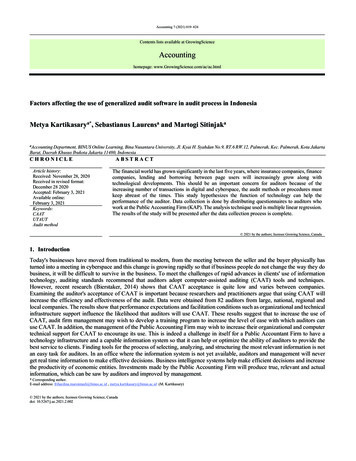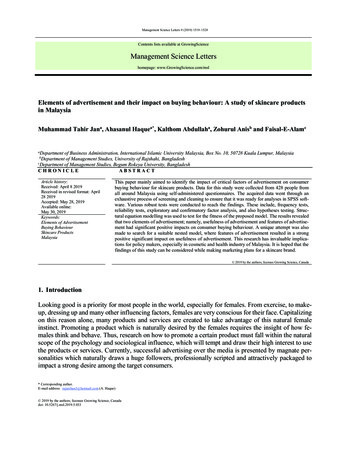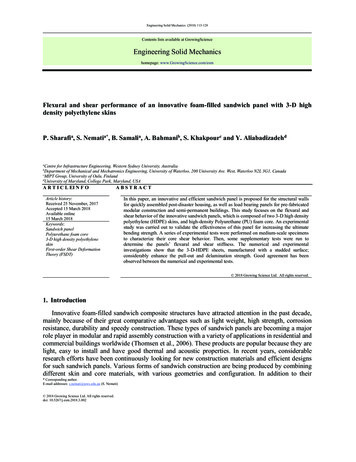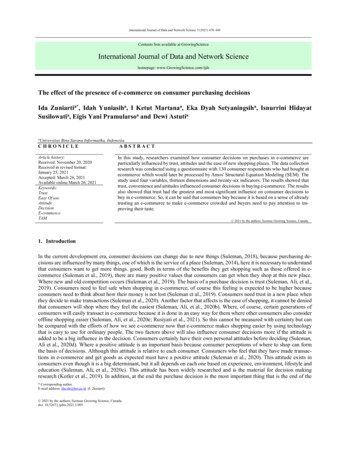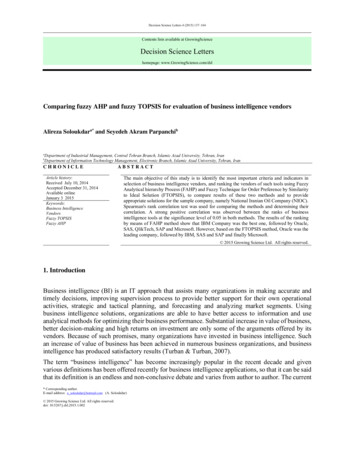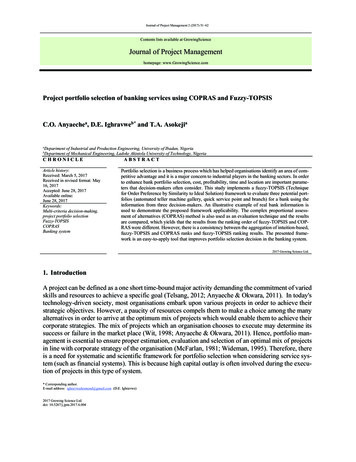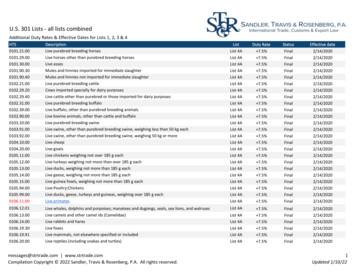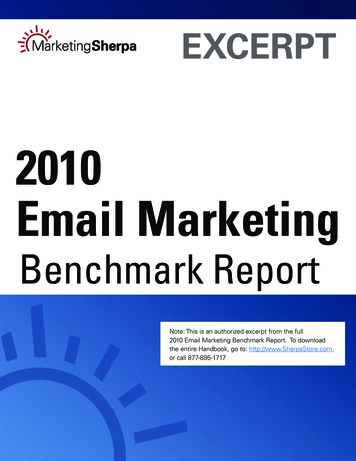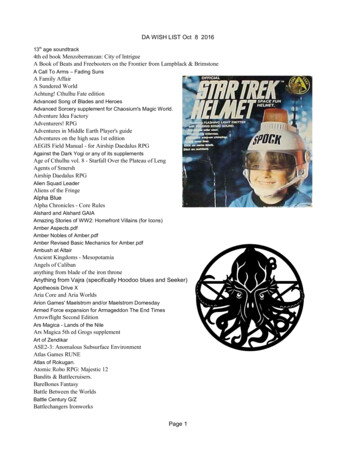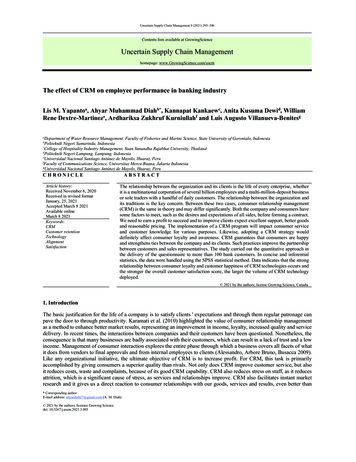
Transcription
Uncertain Supply Chain Management 9 (2021) 295–306Contents lists available at GrowingScienceUncertain Supply Chain Managementhomepage: www.GrowingScience.com/uscmThe effect of CRM on employee performance in banking industryLis M. Yapantoa, Ahyar Muhammad Diahb*, Kannapat Kankaewc, Anita Kusuma Dewid, WilliamRene Dextre-Martineze, Ardhariksa Zukhruf Kurniullahf and Luis Augusto Villanueva-BenitesgaDepartment of Water Resource Management, Faculty of Fisheries and Marine Science, State University of Gorontalo, IndonesiaPoliteknik Negeri Samarinda, IndonesiaCollege of Hospitality Industry Management, Suan Sunandha Rajabhat University, ThailanddPoliteknik Negeri Lampung, Lampung, IndonesiaeUniversidad Nacional Santiago Antúnez de Mayolo, Huaraz, PerufFaculty of Communications Science, Universitas Mercu Buana, Jakarta IndonesiagUniversidad Nacional Santiago Antúnez de Mayolo, Huaraz, PerubcCHRONICLEArticle history:Received November 6, 2020Received in revised formatJanuary, 25, 2021Accepted March 8 2021Available onlineMarch 8 2021Keywords:CRMCustomer e relationship between the organization and its clients is the life of every enterprise, whetherit is a multinational corporation of several billion employees and a multi-million-deposit businessor sole traders with a handful of daily customers. The relationship between the organization andits traditions is the key concern. Between these two cases, consumer relationship management(CRM) is the same in theory and may differ significantly. Both the company and consumers havesome factors to meet, such as the desires and expectations of all sides, before forming a contract.We need to earn a profit to succeed and to improve clients expect excellent support, better goodsand reasonable pricing. The implementation of a CRM program will impact consumer serviceand customer knowledge for various purposes. Likewise, adopting a CRM strategy woulddefinitely affect consumer loyalty and awareness. CRM guarantees that consumers are happyand strengthens ties between the company and its clients. Such practices improve the partnershipbetween customers and sales representatives. The study carried out the quantitative approach inthe delivery of the questionnaire to more than 100 bank customers. In concise and inferentialstatistics, the data were handled using the SPSS statistical method. Data indicates that the strongrelationship between consumer loyalty and customer happiness of CRM technologies occurs andthe stronger the overall customer satisfaction score, the larger the volume of CRM technologydeployed. 2021 by the authors; license Growing Science, Canada.1. IntroductionThe basic justification for the life of a company is to satisfy clients ' expectations and through them regular patronage canpave the door to through productivity. Karamati et al. (2010) highlighted the value of consumer relationship managementas a method to enhance better market results, representing an improvement in income, loyalty, increased quality and servicedelivery. In recent times, the interactions between companies and their customers have been questioned. Nonetheless, theconsequence is that many businesses are badly associated with their customers, which can result in a lack of trust and a lowincome. Management of consumer interaction explores the entire phase through which a business covers all facets of whatit does from vendors to final approvals and from internal employees to clients (Alessandro, Arbore Bruno, Busacca 2009).Like any organizational initiative, the ultimate objective of CRM is to increase profit. For CRM, this task is primarilyaccomplished by giving consumers a superior quality than rivals. Not only does CRM improve customer service, but alsoit reduces costs, waste and complaints, because of its good CRM capability. CRM also reduces stress on staff, as it reducesattrition, which is a significant cause of stress, as services and relationships improve. CRM also facilitates instant marketresearch and it gives us a direct reaction to consumer relationships with our goods, services and results, even better than* Corresponding authorE-mail address: ahyardiah27@gmail.com (A. M. Diah) 2021 by the authors; licensee Growing Science.doi: 10.5267/j.uscm.2021.3.003
296any market analysis, by opening contact lines with your consumers. Good CRM also helps grow business and leads clientsstay longer; customer churning reduces as new customers are referred to more satisfied clients; fire-fighting and problemshooting staff reduces demand, organization service flows are reduced and teams work more efficiently and happier (Beckeret al., 2009). The happiness of the consumer is a significant CRM attribute, which cannot be circumvented. Indeed, customersatisfaction is central to successful application of the marketing concept. Most vision statements and strategic campaigns oforganizations are intended to boost consumer loyalty (Blery & Michalakopoulos, 2006). The idea of relationships is quitebroad, since it applies to various fields, but it can be defined or represented as a distinct form, topics such as marketinteraction, consumer behavior, and customer experience management in terms of subject matter. To render specific facetsof market interactions clear and observable (Blery & Michalakopoulos, 2006), consumer experience management is targetedat providing a comprehensive and integrated understanding of client partnerships and the importance of market ties overtime.In the end, an improved CRM model supports both: Strategic research and development efforts of businesses,CRM concepts applying methods and strategies.As a result of the effectiveness and intensity of the concept of CRM, customers would benefit from it through experiencingenhanced product delivery and organizations themselves would gain from it through increase in customer database, increasein performance and profitability.2. Statement of the ProblemThe key goal of a company is to satisfy consumers' expectations that contribute to improved productivity and demonstratesthat market practices are useless without the presence of consumers. Companies sometimes neglect their consumer serviceand partnership and therefore shift much of their consumers ' purchasing preferences towards businesses that best representthem. The dilemma here is that the interest, treatment and consideration of clients go way beyond the price of the goods.Organizations also continue to do their hardest to maintain and even draw additional consumers.Organizations at times are faced with the problems of Effectively targeting customersDeveloping strategy to achieve target behaviors.Behavior maintenance.Segmentation of customers based on customer profile and customer life-cycle stage.Organizations have implemented different approaches and techniques to ensure they accomplish the following. Theresearch seeks to determine the influence or effect on company efficiency of client relationship management and find out: To what extent does customer relationship management enhance a high level of performance in the organization?How does good customer service affect the level of productivity in an organization?What class of customer or classes of customers should enjoy the benefits of managing a customer relationship?What strategies should organizations take in seeking to achieve a successful and effective customer relationship?Should customer relationship management be included in the banking industry?The objective of this study is to find out whether there is any link or relationship between customer relationshipmanagement and organizational performance. The specific objectives this study is aimed at are stated as below: To find out what propels customer loyalty,To bring out the distinction between customer relationship and organizational performance,To show that customer relationship management is a tool for acquiring high organizational performance,To determine the role customer service relation plays in every organization.This research concentrated on the effects of the corporate success of customer relations management in the banking sector.A strong program of customer relations is critical and extremely important for all market organizations’, but the mainemphasis has been on the influence of customer relations in the banking sector in the light of these research projects.
L. M. Yapanto et al. /Uncertain Supply Chain Management 9 (2021)2972.1 Research on customer relationship management (CRM)Various outsourcing market work on CRM has been performed in various areas such as Bank and financial services(Caruanas, & Pitts, 2012), healthcare (Chahal & Kumari, 2011), tourism and many travel divisions such as destinationmarketers. Essential performance drivers’ technical changes and CRM engineering failures were central to CRMimplementations (Ang & Buttle, 2006) issues linked to obstacles. Many CRM studies included subjects such as CRM bestpractices (Coltman 2007), CRM philosophical frameworks and the CRM recommendations. Although most of the workwas technical in nature, there is also a continuing increase of research on social CRM. Several scales were built to quantifyvarious facets of CRM. Coltman (2007) established and validated a metric scale for the condition of CRM adaptation infinancial companies utilizing measurements such as CRM, information management and technology-based CRM.Dimitriadis and Stevens (2008) explored the generalizability size and applied it to the banking and insurance industries.They established a scale for the analysis of CRM capabilities based on the services industry in general: consumerengagement efficiency, customer relationship performance enhancement, and customer recovery capability.A calculation framework to explain the CRM method has been built based on a broad range of business sectors. (Stevens etal., 2008) and comprises seven specific systems, including, targeting management, consumer experience management,product / service configuration, extension management. During the three phases: introduction, repair and termination inconjunction with various financial services firms, lodging, online store, and power resources, they checked the CRMmechanism implementation. Zikmund (2000) looked at backstage CRM, which requires execution, in a similar manner tothe other dimensions in CRM. Evidence suggests that CRM practices in the front stage involving customer behaviors acrossnumerous interactions have not experienced a systematic development process. From the point made by Zablah et al. (2004)regarding the low emphasis on research that measures CRM 's success from a consumer viewpoint, the value of front-stageCRM can also be established. CRM is supposed to provide the companies with various benefits, according to the literature.The advantages of the CRM theory itself and the disadvantages of CRM structures can be separated into two large classes.In the fields of consumer recruitment, customer growth, maintenance of clients, business creation, and client equity increaseare the advantages of CRM. Richards and Jones (2008) identified seven key benefits of CRM systems: enhanced customeroriented focus, improved channel-wide preferential service offering, improved sales force efficiency and efficiency,personalized marketing messages, personalized products and services, increased customer service efficiency, and efficiencyand improved pricing. Although the CRM philosophy offers broad advantages, much of the advantage of CRM is discussedon the basis of the implementation of a particular system of CRM (Winer, 2001). The organization has not been studyingmuch into the benefits gained from the cumulative CRM experience. There are various tests of the performance of CRMapplications. Winer (2001) used the customer interest assessing method in the banking sector. He assessed CRMperformance across the company's image and level of service in the hotel industry. He proposed a holistic method that theoutcomes of CRM be calculated using the measurements of asset worth, company asset and partnership equity (Bligh,2004).While researchers regularly point out that CRM produces loyalty, only a few studies analyze the impact of CRM on loyalty.The value of CRM is further simplified by emphasizing its consumer benefits. There has been wide-ranging discussion ofnon-financial relational benefits, including confidence benefits, social benefits and special care benefits. The advantages oftrust include learning what to expect from service sessions, decrease in distress and faith in the planned operation. Theadvantages include informal recognition of social security programs (Bligh, 2004). The preferential preference advantagesinclude premium cuts, smoother and supplementary facilities. He said that trust advantages are the most effective. Giventhe aforementioned benefits for the partnership dyad parties [the company and the customer, the advantages listed previouslywere highly discussed for both parties. Several researchers suggested the CRM findings in firm efficiency wereoptimistic. It is also observed that CRM is an immense expense with no incentive and no verification of success. In fact,academics have raised reservations about their empirical proofs. Many tests have shown that CRM structures have beencrashing. In the evaluation of many Rigby et al. systems (2002), 55% were unsuccessful. In addition to researchers, largeindustry analysis companies, including Gartner and Mckinsey, have released a variety of papers on CRM deploymentperformance and failure rates. However, many of the debates on CRM loss are regarding not only the theory itself but alsoCRM apps. Consumer questions over the quality of partnership building activities have been identified. Danaher et al.(2008) studied the value of partnership transfers in three kinds of business organizations: telecommunications providers,banks, physicians, and analyzed customers' desire to participate in relationships. When contrasting with the other twoservices markets, they find that consumers are more involved when connections with physicians. This showed thatcustomers are more willing to maintain long-term relations when the service provider is viewed as an authority, social tieswith the company and frequent interactions with the service provider are important to the nature of the service. Verhoef(2003) rationalized the customer's reluctance to stick with a single company because of fears over missing options and theneed for something different. Therefore, although some consumers would choose to establish a long-lasting partnershipwith certain company organizations, some may opt differently purposefully, based on the business background. It istherefore necessary to evaluate consumer aim for introduction of relationships before approaching customers. Johnston(2004) defined relationship initiation as “an intention of a customer to build a relationship with a firm while buying a productor service attributed to a firm, a brand, and a channel” Accordingly, the lack of customer interest in initiating relationshipsis referred to as a transactional intention.
2982.2 Customer relationship management (CRM)Several reasons led to CRM use in hotels. Amongst them is the homogenous nature of the hotel sector and the need todistinguish its central offering from its rival. Although the value of CRM adoption has been emphasized by globalizationand consequently international pressure, certain factors, like IT technology changes, have been helpful in successful CRMimplementation. This makes CRM important and convenient to adopt environmental conditions. The hotel industry is areliable industry for information. All hotels and their guests have been affected by the quality of knowledge. Customerinformation plays an extremely important role in the practice of CRM from the hotel point of view. However, customeroriented exposure to a broad range of user-generated contents has posed several obstacles for hotels (Jhonston, 2004).Although consumers have no limitations on details, this provides travelers with a wider option. It makes things simpler andenticing for travelers to turn. As a consequence, consumer attrition and rising acquisition costs are encountered in hotels.The adverse effects in such a context were recommended to be overcome by CRM. In the practice of CRM in the hotelcontext, information technology (IT) has played a vital role. Several researches addressed how IT capability could be usedin CRM deployments and how to develop electronic interaction management systems. The key function that hotel websitesplay in developing consumer ties was noted by Venetis and Ghauri. (2004). The major effect of CRM activities and Internetuse on consumer service and loyalty, on interaction and on establishing and sustaining quality ties with consumers has beendescribed by Ghauri (2004). He addressed how the IT facilitates the gathering of details at different points of concern, suchas bookings, check-in, check-out meetings and on-site stays. It helps hoteliers, according to hotel tastes, to customize uniqueguest packages, facilities and promotions. CRM analysis in the hotel setting, close to conventional study, focuses largelyon issues relevant to deployment. This propensity to concentrate on the application of CRM tends to be warranted in thecontext of the poor performance of CRM implementations in the hotel sector. The CRM work based on applicationsenhanced (Sarmaniotis et al., 2013). Various steps were taken to assess the impact of CRM in the hotel sense. It includesloyalty, (Dwyer & Tanner, 2005), business success, partnership consistency, & client life-time value (CLV). It includesloyalty, business performance. CRM success assessment is primarily focused on CRM which analyzed the context aspectsof CRM instead of the customer's experience. Consequently, the CRM efficiency assessment activities of hotel clients havebeen restricted to the maximum standards. In the hotel context, the researchers have listed numerous customer-orientatedCRM practices. Farquhar (2004) for example suggests that CRM was historically applied easily, such as consumerknowledge, client interaction, conversational habits and organizational skills. With the wide usage of technology, currentCRM serving consumers has common activities such as staying in touch with clients continuously, direct texts, flyer milesor coupons on certain items, exclusive offers, due acknowledgement calling the consumer by email, rewards services, blogsand tailored mails, and to consumers. Given the multiple CRM activities in the hotel industry, many approaches remainrestricted by observational studies with the exception of the reward schemes (Ghavami & Olyaei, 2006). CRM has a positiveeffect on the efficiency of partnership, while partnership consistency has a positive impact on the importance of consumerexistence. The effect of connection efficiency on consumer satisfaction was calculated by a survey of hotel guests in Taiwanon the basis of consumer-faced CRM activities in the hotel industry (Ghavami & Olyaei, 2006).The CRM's causal link to the effects has been defined by partnership consistency by both Gifford (2002) whereas theconfidence and loyalty by Greenberg (2004) have been established. In fact, a mixture of mental and disposition variablesassessed the efficacy of CRM. These three reports analyzed tourists to a particular location. The participants were also acombination of individuals who worked both for pleasure and company. In contrast to the above studies which sampled acombination of business and leisure travelers to a particular destination, this study investigates the impact of CRMexclusively in the leisure travel market. Since this research aims to examine choices of hotels at a foreign location in general,this analysis was not restricted to a single country or hotel. There are directly determined relationships between CRM andits outcomes. The outcomes of CRM were measured based on behavioral loyalty—repeat visitation and word-of-mouth. Aneed to understand the direct impact of CRM upon repeat visits and words of mouth is the reason for choosing behavioralloyalty. Its approach will produce a detailed customer-facing appraisal of CRM.2.3 Loyalty programs as a customer relationship management (CRM) practiceCRM's reward services are a crucial case. According to Greve (2006), consumer growth, market engagement and customermaintenance are basically CRM's rewards services. According to Becker et al. (2009), a repeated buying and engagementof the consumer is an essential consequence of reward initiatives through creating strong partnerships. Loyalist schemes,because they are perceived to be less price-sensitive, expend a lot of time and promote constructive WOM, have oftenproven successful because of the decreased costs of servicing loyal clients. This is evidently valid in the hotel sector, aswell as in other associated sectors such as aeronautical firms, hotels, shopping and merchandising (Becker et al., 2009).Several researchers have observed a proliferation of reward schemes. Lewis (2004) indicated that travel related sectors suchas aviations, hotels and rental cars are especially successful in reward programs. First in the aviation market, with the launchof a flyer frequency system in 1981, reward schemes started in the hospitality and tourism industry. In the hotel sector also,loyalty programs were becoming considerably popular. The Holiday Inn and the Marriott first implemented rewardsschemes in the hotel industry in 1984, and the writers refer to them as 'homecoming services' or 'homecoming initiatives.'Already rewards programs, both at large and in small hotels, have grown into an integral hotel policy (Guo et al., 2008).The introduction of hotel reward schemes can be explained by helping to resolve pressure and boost market share. Inaddition, consumers were encouraged to purchase again and to chart their usage habits. Hair et al. (2007) reported an
L. M. Yapanto et al. /Uncertain Supply Chain Management 9 (2021)299increase in occupancy and competitiveness in the hotel market rewards programs. In the luxury business field, rewardsschemes are increasingly common in contrast to the general segment (Guo et al., 2009). The study found out that rewardprograms are more common among enterprise and high-income travelers. The study looked at business context to look atdifferences in loyalty programs between members and non-members. It was observed that participants of the reward systemwere willing to pay higher prices than non-members. Skogland and Siguaw (2004) also acknowledged the inability ofrewards programs in trying to deliver the expected benefits given the value added to loyalty programs in the hospitality field(McCall & Voorhees, 2010). DeKay (2009) identified the principal reason for the lack of loyalty in the recreational area asless frequent journeys and fewer redemption opportunities in comparison to travelers. The financial advantages of rewardservices tend to be unclear, primarily because management metrics to assess them are not appropriate. Juan and Yan (2009)also reaffirmed the value of engaging in alternate CRM action. The claims further highlight the previously mentioned valueof customer-facing observational work on CRM activities.2.4 Other loyalty generating stimuli in the hotel contextBeyond CRM, several other triggers for replicated and word-of - mouth generation have been addressed. We also providestandards of operation and hospitality (Kandampully & Hu, 2007). While the predicted effects are the same, the boundariesbetween them and CRM remain very unclear. Where human resources are one of CRM's core components, however, theconcepts of hospitality clients' services and service quality (Keramati et al., 2010) were also found to have been one of thekey concepts. A mixture of complete quality management (TQM) and Complete CRM is a direct association between CRMand price. Level of relation has been one of the main measurements of standard of service assessment. Keramati et al. (2010)across dimensions like relative interest at location, amenities and timeliness conceptualized the partnership standard in hotelservices setting. Chen and Chen (2014), by a mixture of CRM and non-CRM measurements, conceptualized the consistencyof relationship: efficient and severe operation, equipment functional, health and climate.Many of them will not explicitly impact organisations' CRM activities. As described in early parts in the study (Keramatiet al., 2008) conducted main practices concerning the application of CRM: creation of a core service, the improvement ofthe partnership with specific clients, the enhancement of the core service by extra benefits. It is evident from Berry thatother measurements, which cannot be linked to the organization’s CRM activities often, are essential to the growth ofconsumer relationships. CRM is commonly called loyalty-building practice. Nonetheless, all of the other factors such as thestandard of service is mostly addressed through observational explanations on loyalty management methods rather thanCRM. As a result, the importance of the CRM aspects to loyalty production was not sufficiently understood by the CRMcommunity. It implies that the area of CRM activities needs to be identified. CRM is defined as all CRM-related practicesin this study "three buy-time zones, pre-countering, interaction and post-encounter," which have the effect of contributingto the field of CRM.2.5 CRM and CustomersCRM is significant, because it gives an organisation's multiple marketing advantages that daily data collection surveys areno longer required, because CRM is a continuous operation. This can be done by purchasing and consuming activity, aswell as experience, any time they purchase and transact (Keramati et al., 2008). CRM also makes an enterprise reallycompetitive. At first a consumer may be over marginal profits, but after a period of time, consumers can becomecompetitive. It ensures that the company will begin to reap its rewards. It is also really important to improve revenue andmarket share because it provides more incentives and brand equity for the development of a customer's franchise. CRMhelps other companies, as it has a beneficial impact on the consumers, who are switching to its technologies.2.6 Customer satisfactionThere is no doubt about the value of consumer loyalty. Holding consumers is much better than getting fresh ones. Therefore,it is important for a company to ensure that an entity keeps its customers. That's what makes a business important forconsumer service. This is described as a marketing concept that allows one to recognize whether an organization's goods orservices match or surpass consumer standards. This can be defined in the time period for the product or service as satisfyingconsumer desires, demands and wishes. Customer loyalty is vital as it lets business owners and executives’ control anddevelop their organizations. Another downside is that consumer loyalty is found in a dynamic market environment in whichcompanies will contend for consumers. This is important that the survey projects thoroughly concentrate on customercritical problems (Lawson-Body & Limayem, 2017). Consumer satisfaction provides a great deal of benefits from helpingto recognize incentives open for service and product improvement, to appraisal and compensation schemes. It can also bedescribed as a consumer's quantification of his / her feelings about the perceptions of a commodity, whether it is gratificationor frustration. The consumer's reaction to and appraisal of the presumed difference between prior expectation and the actualproduct experience following consumption is complied with. That generally implies that consumer loyalty is accomplishedif services are offered that exceed customer standards if services are less than anticipated.
300The satisfaction of customers is often described as an assertion that customer interaction was as wonderful as it should havebeen. Satisfaction is not merely a response but rather an emotional reaction to the perceptions of individual goods or servicesthat are purchased, retail stores or also molar activity trends such as browsing and purchasing preferences and the generalmarketplace. The psychological state arising from unclear intentions and from user emotions regarding a purchasingenvironment is another concept of customer satisfaction (Levesque & McDougall, 1996).2.7 Relationship between Service Quality Attributes and Customer SatisfactionQuality of service and the interaction between consumers have a relationship that is very transparent and based on qualityperception and consumer loyalty. One persistent concern is whether a partnership can be challenged as regards consumerloyalty and service efficiency. Because of the lack of knowledge of consumer expectations and resources, most qualitydesigns crash. Effective service efficiency characteristics will only have beneficial consequences. Tangible, consistent,assurance, receptiveness and empathy are the standard of service qualities that result in consumer loyalty. Tangible facilitiessuch as technologies and utilities can please consumers while talking about tangible and consumer loyalty, whereascustomer satisfaction is diminished by the lack and/ or bad tangible facilities. Secondly, as we understand continuity andconsumer delivery, the most significant characteristic of customer loyalty in terms of service efficiency might be, forexample, telecommunications reliability. Thirdly, the strong partnership between insurers and consumer loyalty is clear. Itis a positive one. Finally, the connection is favorable in terms of reactivity and consumer loyalty, as long as the serviceprovider reacts to the customer helpfully and swiftly. Customers' references and ads are an important way to get newcustomers because the first-time quality is not
To show that customer relationship management is a tool for acquiring high organizational performance, To determine the role customer service relation plays in every organization. This research concentrated on the effects of the corporate success of customer relations management in the banking sector.
